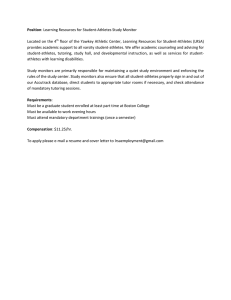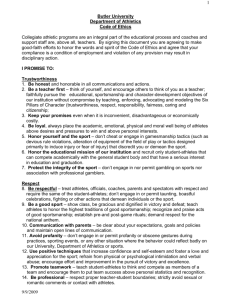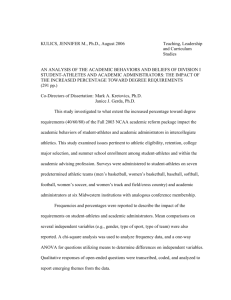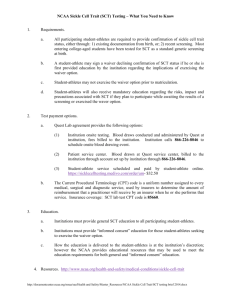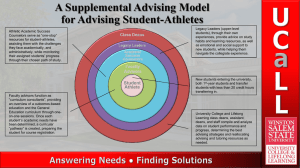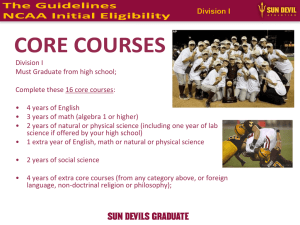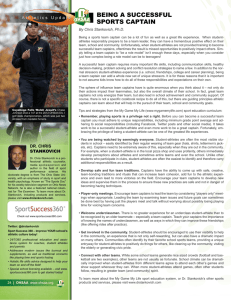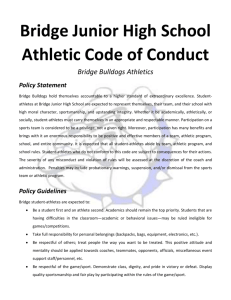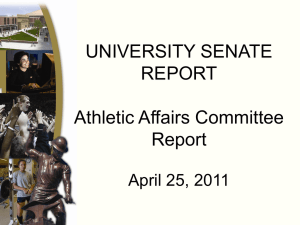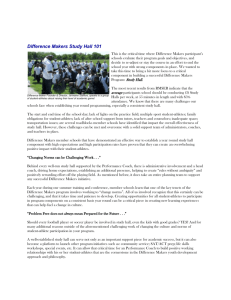Strategies for Efficetively Addressing the Behavioral/Mental Health
advertisement
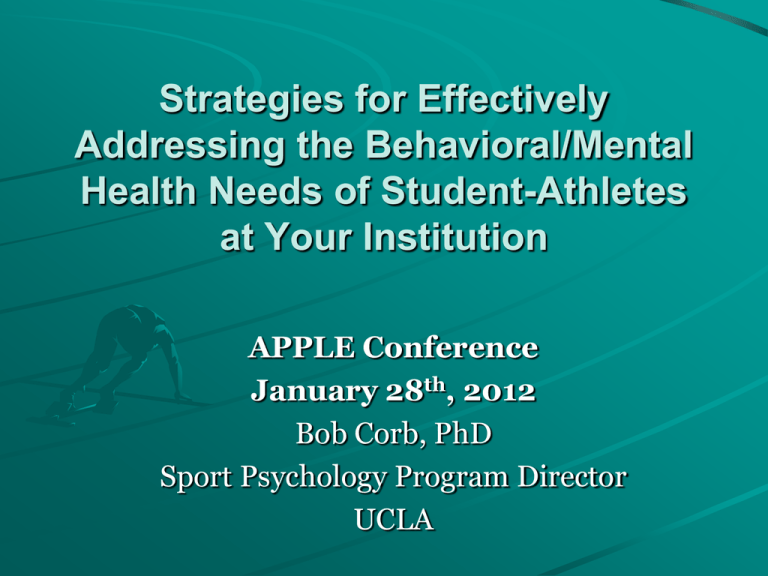
Strategies for Effectively Addressing the Behavioral/Mental Health Needs of Student-Athletes at Your Institution APPLE Conference January 28th, 2012 Bob Corb, PhD Sport Psychology Program Director UCLA By Way of Introduction: De-stygmatizing the Need for Mental Health Services Ron Artest wins championship, thanks therapist Pat Summitt Statement - YouTube My situation: Me and Michael J. Fox Three Questions to be Answered Today What makes student-athletes different from non-athlete students? What can student-athletes reasonably expect at my school? How do I make sure student-athletes get the services they need at my school? What Makes Student-Athletes Different From Non-Athlete Students? Task of Adolescence: Establish identity “Athlete” is part of that identity S-As experience the world differently than non-athlete students: injuries; ATOD Mental health needs of S-As will be similar but also differ from non-athlete students Primary Clinical Concerns of Female Athletes Depression Relationships Teammates Coaching Staff Family of Origin Dating/Romantic Eating Disorders/ Body Image Concerns Self-Esteem/SelfConfidence Relationship Violence Transition to University/Division I Environment Alcohol Abuse Sexism Primary Clinical Concerns of Male Athletes Relationship issues Substance Use/ Abuse Alcohol Marijuana Steroids Nicotine Cocaine Other Drugs Anxiety Depression and/or Suicidality Anger Management Declining Athletic or Academic Functioning Injury Related Concerns Other Potential Areas of Clinical Attention Learning Disabilities Self-esteem and/or Confidence Performance Enhancement Transition into College Homesickness Academics Demands of Collegiate Athletics End of Academic and/or Collegiate Career Other??? What Can Student-Athletes Reasonably Expect at my School? Level of service available to S-As determined by institution's values related to inter-collegiate athletics Mainstreaming vs. Specialized Delivery of Services; NCAA “extra benefit” rule III tier system w/ some exceptions Division III: The Student-Athlete Experience “Division III features student-athletes who are subject to the same admission standards, academic standards, housing, and support services as the general student body.” (ncaa.org) S-As are in the mainstream; student psychological services may NOT be prepared to meet unique needs of student-athletes S-As must advocate for themselves and their mental health needs Division II: The Student-Athlete Experience “Division II provides an intersection where athletically gifted students can compete at a high level, while maintaining much of a traditional collegiate experience. The Division II emphasis is on balance, with the objective of providing student-athletes a comprehensive program of learning and development. Student-athletes are encouraged to achieve excellence in their sport, in the classroom and in their community.” (ncaa.org) S-As may be mainstreamed for financial reasons but may need specialized services; mental health needs of many S-As not being met S-As must advocate for themselves and get the support of coaches and DIA in order to meet mental health needs Division I: The Athlete-Student Experience “Division I member institutions are expected to be nationally competitive, to offer broadbased participation opportunities for men and women, and to be as economically selfsufficient as possible.” (ncaa.org) S-As frequently receive specialized delivery of services, which may include sport psychology (housed in DIA or CAPS) S-As must fight stigma associated with asking for help; help is available but S-As often afraid to ask (confidentiality) How do I Make Sure Student-Athletes Get the Services They Need at my School? Understand what is reasonable to expect based on the priority your school puts on intercollegiate athletics Wherever possible, S-As must fight the stigma associated with S-As seeking mental health services; normalize, educate, advocate S-As must be conscientious consumers of ALL student services; establishing one’s identity includes individual responsibility Division III: Specific Strategies (focus on “Educate”) Identify faculty/staff supportive of S-As and get them involved (Psychology; Kinesiology; etc) Make them fans of DIA and individual S-As Teach a sport psychology class Independent study/research Outreach by CAPS on topics of interest (PST; ED; etc) Work with DIA to de-stygmatize and prioritize the mental health of S-As SAAC Athletic trainers and sports medicine staff Coaches as educators educating the whole person Use outside resources: Graduate programs in Sport Psych Individual, team, and departmental interventions Other??? Division II: Specific Strategies (focus on “Advocate”) Work w/in DIA to maximize resources Sports medicine; strength and conditioning Suggest outside resources (Graduate Sp Psyc programs) SAAC/SAMs Make connections w/ on-campus student services: Assume they want to meet S-A needs CAPS Health Center Career Center Residential Life Academic Advising Faculty/staff Other??? Division I: Specific Strategies (focus on “Normalize”) Expect and demand needed services w/in DIA: Identify “allies” and “gate keepers” AS2 Sports medicine Strength and conditioning CHAMPS Life Skills Sport psychologist SAMs Approach on-campus resources expecting that they want to serve an under-served population but won’t know how CAPS Academic advising Career Center Residential Life Step-Up: Bystander involvement Other??? NCAA Resources Managing Student-Athletes' Mental Health Needs Other??? Bob Corb, Ph.D. Sport Psychology Program Director, UCLA rcorb@caps.ucla.edu
